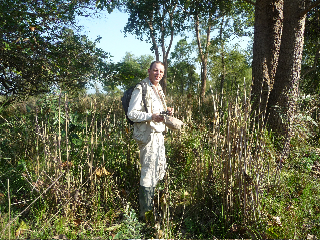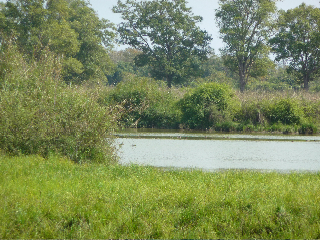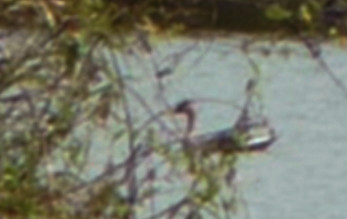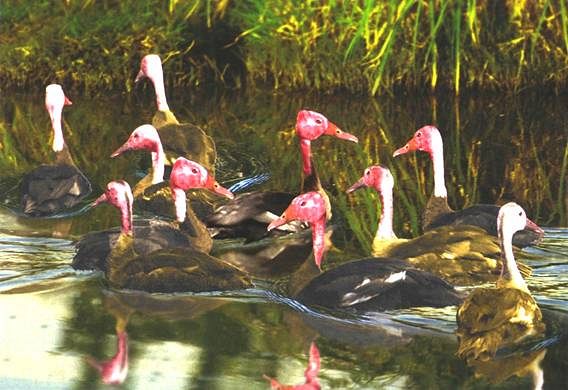
April 17, 2009
One of the more long-standing cryptozoological pursuits among birds is the search for the pink-headed duck (Rhodonessa caryophyllacea), a large diving duck of Asia.

Has a Cryptomundo correspondent Richard Thorns, shown above, snapped a new photo (see below), giving renewed proof of the continued existence of this mysterious avian cryptid?

Does the pink-headed duck still survive? © Richard Thorns, 2009. Used with permission.
This duck’s range was in eastern India, Bangladesh and northern Myanmar, but contemporary opinion is that the species is now probably extinct. Perhaps it is not gone, after all.
First, the standard background on their conservation status:
It was always rare, and the last confirmed sighting was in 1935, although unconfirmed reports from India persisted until the early 1960s. In 1988, Rory Nugent, an American birder, and Shankar Barua of Delhi, reported spotting the elusive bird on the banks of the Brahmaputra. The pair started their quest for the bird at Saikhoa ghat on the north-eastern end of the river on the Indian side of the border. After 29 days of sailing, Nugent said that he saw the pink-headed duck amidst a flock of other waterbirds. However, Nugent’s and Barua’s claimed sighting has not been enough to remove this duck from the list of extinct birds. Reports of pink-headed ducks were for decades received from the largely unexplored Mali Hka and Chindwin Myit drainages in Northern Myanmar, and apparently still continue. While the area is not very well surveyed by scientists, searches have been inconclusive and confusion with the Red-crested Pochard and the Spot-billed Duck has been a common source of supposed Pink-headed Duck sightings. A report on a survey in the Hu Kaung valley in November 2003 concluded that there is sufficient reason to believe that Pink-headed ducks may still exist in Northern Myanmar’s Kachin State, but a thorough survey of the Nat Kaung river between Kamaing and Shadusup in October 2005 failed to find this species; a number of interesting ducks were observed, but they turned out to be Spot-Billed Ducks or White-winged Wood Ducks. Suggestions have been made that it may be nocturnal. Source.
Thus, basically, before 2009, there are two acknowledged unconfirmed sightings, both from remote wetlands of Myanmar. Five Pink-headed Ducks were reported from Mali Kha River near Machanbaw in the state of Kachin in winter of 1965/66. In winter of 2004, a team from Birdlife International reported a probable sighting of this duck from Kachin (Myanmar).
Sightings such as the one in 1988 by Rory Nugent and Shankar Barua are not usually sanctioned. Frankly, I find they are too often dismissively ignored. But how about one with a photograph of the pink-headed duck?
There is some intriguing 2009 news.
Richard Thorns has published and shared his remarkable observation that he may have encountered, sighted, and photographed the pinked-headed duck. In his newly posted, “Anecdotal reports of possible living Pink-headed Duck in the ’98 Inn’ area between Bhamo and Myitkyina, Kachin State, north Myanmar. Jan’-Feb’ 2009,” Thorns shares his notes on his fieldwork.
Thorns decided to search for the bird, and followed the trail of the pink-headed duck into ancient Burma (Myanmar).
I recommend you go to his website to read his diary entries. I will instead concentrate on the photographic evidence he has sent me.
On February 14, 2009, Richard Thorns and his guide were watching a local lake (part of what he called the HunterFarmer lake complex, N 24°23.074’ E 97°13.974’) when he saw a duck and photographed it. Here is what he wrote:
Despite the lack of wildfowl activity on lake 2, it was on this lake in the afternoon that I observed a duck from a distance of perhaps 0.25 miles. I was drawn to its pink colouration and what appeared to be a dark stripe on the throat. There was also a sharp contrast in colouration between its head and dark body, and I was especially struck by its very long, almost serpentine neck. I was not close enough to see if the maxilla showed the Pink-headed Duck’s steeply-inclinating, rather goose-like silhouette against the water, nor did the bird make any sound.
For me, the above features of colour, contrast, long-necked posture and possible throat-stripe were initially outweighed by what seemed to be a white flash on the wing, and to be truthful from that moment on I did not give the photograph too much attention. It was not until it was suggested to me that the ‘white’ was very far back on the wing – almost not on the wing – and that it may be sunlight reflecting off two leaves to the right of the branch that vertically crosses the bird’s body, that I began to take an interest again.
Indeed, if these two white ‘flashes of light’ are covered; as soon as this is done then the photograph instantly seems to take on a whole new meaning. But there are other caveats: the dark area around the head, for example, could be taken as shadow, which strengthens the case for an un-mottled pink head, but at the same time debunks the dark throat-stripe which seems to extend upward from the belly.
Here is the long shot of how the photograph looks (unfortunately, greatly reduced to fit on this page’s width):

© Richard Thorns, 2009. Used with permission.
But when Thorns increasingly enlarged the image, he revealed what might be the first photograph of a pink-headed duck seen in years:

© Richard Thorns, 2009. Used with permission.

© Richard Thorns, 2009. Used with permission.
So what does a pink-headed duck look like? There, of course, have been paintings, in which the coloring has been vividly depicted.

More significantly, there is a photograph of the pink-headed duck, before they were declared almost certainly extinct.

As far as is known, the last captive pink-headed duck died in 1936 in Delacour’s collection, Cleres, France. This black-and-white photograph was colorized for Frank Todd’s book Natural History of the Waterfowl California: Ibis Publishing, 1996. This was used from Kumar, et.al., Handbook on Indian Wetland Birds and Their Conservation, 2005.
In an exclusive interview with me, Richard Thorns was careful and cautious to point out his reservations.
He writes:
The really big thing about the pic of the duck is that I was mainly, instinctively, looking for the shade of pink – forgetting of course (in 37 C temperatures) that strictly speaking it was not summer, even though in February it felt like it to me. So perhaps the plumage MIGHT be paler, winter plumage? I am no expert on how the Asian seasons affect plumage but if that theory holds water then I suppose it follows that naturally you would not see the deep, rich pink you would instinctively be hoping for. Instead maybe I should be looking for posture.
Also, as I mentioned in the diary, I was sure the two white flashes were evidence of white-winged duck until somebody pointed out it looked like light reflecting off the leaves. THEN I became interested, all right. And then there is that long neck; as far as I know Spot-billed Duck or White-winged Duck (and certainly not Ruddy Shelduck) have this posture? Pygmy goose? But then there is the shade and in any case I don’t think it was any species like that because we would have seen others – we were there for 5 days.
You’ll notice all these question marks after my sentences 🙂 I suppose I am nervous of giving the impression I am claiming a possible sighting of a Pink-headed Duck (as would be normal, I think). If you could be very kind and state this in your article – and make it plain I am more interested in identifying the mystery duck on the lake (and possibly with direct comparison to the other two pics) than making any other such claim I would be very happy if you could do that. I think the site is a wonderful one and I think, like me you share a passion for just this sort of story and obviously a deep love of cryptozoology in general. I think it appeals to something very deep within us. 🙂
Best.
Richard.
PS I also have camcorder footage of the farmer recognising the bird on the flashcard – but please be aware that he had to repeat this moment as, and this is a typical crypto-moment, at the time I thought: “This is gonna amount to nothing” and had the camcorder firmly in my bag to save the battery.
Yes, so, to be clear, no specific claims of seeing a pink-headed duck are being made by Richard Thorns, and I get all the blame for bringing this to the greater cryptozoologically-aware public’s attention. But, the discussion, the wider debate on what Mr. Thorns saw and photographed must begin somewhere, and why not at Cryptomundo, of course. We are not afraid here to call a cryptid duck quest merely a wild goose chase, if that is what this turns out to be. Or to be open-minded about the possible survival of an allegedly extinct species, either.

This historic illustration is from Hume and Marshall’s Game Birds of India, Burmah and Ceylon. Illustration does not show crested appearance of head.
Richard Thorns’ diary conclusions are worthy of posting, for reading here, too:
The feeling that I first experienced, when I first received that positive reaction to my I.D picture in a field north of Bhamo, is something that’s going to be very difficult to forget. Likewise, when approaching a lake that you know is largely undisturbed, and seeing ducks on it and knowing right there and then and at that very moment you could soon be making history is, again, something hard to erase from memory. This, I suppose, is what field trips are all about. The collection of scientific data, field notes and shots are all of paramount importance, of course, but it’s equally important to remember that, behind all of that, even today people still search for the lost Dutchman’s mine in the deserts of North America. In Burma, on the trail of the Pink-headed Duck and amongst better people than me, I learned it was okay to feel that way
In temperatures nearing 40°c, my own trail finally went cold on the morning of the 20th February 2009; the Pink-headed Duck had escaped yet again. What has always struck me the most about this incredible bird is, I suppose, the fact that for so long in the first part of the 20th Century it had been considered extinct, only to reappear a few years down the line. But it has been a long time now; the gap is widening, unlike the small gap of ten feet that would take the stuffed Pink-headed Duck specimen out of the extinction room at the Paris Natural History museum and back into the area of extant birds. It is a very long ten feet! So here it ends; the heart is big, the spirit is still ever-willing, but the Pink headed Duck remains as tantalizingly and infuriatingly elusive as ever.
Richard Thorns 2009.

What is in the photograph? Is there new hope for the Pink-headed Duck?
Send your support today:
About Loren Coleman
Loren Coleman is one of the world’s leading cryptozoologists, some say “the” leading living cryptozoologist. Certainly, he is acknowledged as the current living American researcher and writer who has most popularized cryptozoology in the late 20th and early 21st centuries.
Starting his fieldwork and investigations in 1960, after traveling and trekking extensively in pursuit of cryptozoological mysteries, Coleman began writing to share his experiences in 1969. An honorary member of Ivan T. Sanderson’s Society for the Investigation of the Unexplained in the 1970s, Coleman has been bestowed with similar honorary memberships of the North Idaho College Cryptozoology Club in 1983, and in subsequent years, that of the British Columbia Scientific Cryptozoology Club, CryptoSafari International, and other international organizations. He was also a Life Member and Benefactor of the International Society of Cryptozoology (now-defunct).
Loren Coleman’s daily blog, as a member of the Cryptomundo Team, served as an ongoing avenue of communication for the ever-growing body of cryptozoo news from 2005 through 2013. He returned as an infrequent contributor beginning Halloween week of 2015.
Coleman is the founder in 2003, and current director of the International Cryptozoology Museum in Portland, Maine.
Filed under Avian Mysteries, Breaking News, Cryptomundo Exclusive, Cryptotourism, CryptoZoo News, Cryptozoologists, Cryptozoology, Evidence, Expedition Reports, Extinct, Eyewitness Accounts, New Species